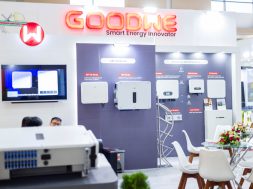
More energy- and cost-efficient batteries will be key to accelerating the adoption of electric vehicles (EVs) and increasing the share of renewable power generation as many countries pledge to make their economies greener in the aftermath of the pandemic. So the race to find the next breakthrough in the most widely used kind of batteries, the lithium-ion battery, is on.
Researchers have been at work for years to develop longer-lasting and cheaper batteries that can store more energy.
Most recently, scientists at the U.S. Department of Energy’s Pacific Northwest National Laboratory (PNNL) have looked at ways to make the battery cathode store more energy at a relatively lower cost. And they think they may have found the solution.
The researchers have worked to improve the performance of the lithium-ion battery by using a cathode that is very rich in nickel and working to overcome one key challenge in using nickel-rich cathodes. The challenge is that high nickel content in the cathode raises the possibility of unwanted side reactions, damages the material, and makes storage and handling difficult.
In a paper published in the journal Science on Friday, PNNL researchers describe their approach to solving the problem of packing the cathode with more nickel than what is currently used in Li-ion batteries. They have used a single-crystal nickel-rich cathode and identified one reason why it hasn’t been used so far— single-crystal nickel-rich cathodes break down because a process known as crystal gliding leads to microcracks.
Currently, the most common nickel-rich cathode is in the form of polycrystals – aggregates of many nanocrystals in one larger particle. The single-crystal, nickel-rich cathode packs at least 25 percent more energy compared to the lithium-ion batteries used in today’s electric vehicles, the PNNL team of scientists say.
They have found that some of those microcracks in the single-crystal nickel-rich structure are reversible through the natural actions of the lithium atoms. In addition, the researchers have looked into several ways to prevent the microcracks, including operating the battery at a common voltage, which minimizes damage. Keeping the size of the single crystal below 3.5 microns may avoid damage even at higher voltages, say the team who are also exploring ways to stabilize the crystal lattice to better accommodate the arrival and departure of lithium ions.
“Nickel is on the drawing board of lithium-ion battery makers largely because of its relatively low cost, wide availability and low toxicity compared to other key battery materials, such as cobalt,” PNNL said in a statement.
Lithium-ion batteries have so far led the way to increased EV sales and renewable energy share. But research into other types of battery chemistry, such as lithium-oxygen batteries, or structural batteries in which the material is the energy storage device, could one day lead to additional viable commercial solutions for EVs and energy storage.
Lithium-ion batteries, in particular, are expected to reach the milestone of a battery pack price of below US$100/kWh within four years. That price is widely considered as the tipping point for mass EV adoption.
Lithium-ion battery pack prices have declined by 87 percent from 2010 to 2019, with the volume-weighted average hitting US$156/kWh last year, according to estimates from BloombergNEF.
“By 2024, battery pack prices go below $100/kWh on a volume-weighted average basis, driven in part by the introduction of new cell chemistries and manufacturing equipment and techniques,” BNEF said in its Electric Vehicle Outlook 2020.
Wood Mackenzie sees battery pack prices dropping below the US$100/kWh milestone by 2024, thanks to economies of scale and technological improvements, and despite the coronavirus-driven crisis.
IHS Markit is even more optimistic—it sees the average cost of a Li-ion battery cell dropping below the US$100 kWh milestone as early as in 2023. In 2030, the average cost of such a cell is set to further drop to $73/kWh, according to IHS Markit’s analysis.
The price of the Iron Phosphate (LFP) Li-ion battery cell has already dropped below $100/kWh this year, and this kind of battery still remains the lowest-cost option. However, lithium-ion batteries with the Nickel Manganese Cobalt (NMC) and Nickel Cobalt Aluminum (NCA) chemistry will continue to hold the majority share of the automotive sector thanks to their higher energy density, IHS Markit said.
“Cost is the name of the game. Technology advances and competition between the different types of lithium-ion batteries is driving prices down,” says Youmin Rong, senior analyst, clean energy technology, IHS Markit.

















